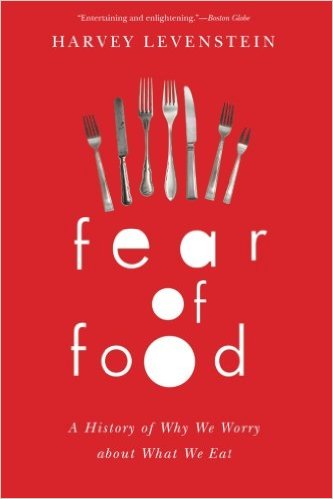
(By Harvey Levenstein. University of Chicago Press, 2012; 218 pp; $25)
Since the world is full of potentially fearful things and few people have time to fear all of them, we’re usually selective. We choose such things as climate change, cancer, Alzheimer’s disease, terrorism, animal rights, various types of intolerance (or even, for some people, tolerance), political instability, and so forth. Each fear has its constituents, and in many instances entire industries have been spawned from the efforts of well-intentioned scientists and policy makers, often reinforced by the not-always-good intentions of media hawks and activists who make careers and money from playing on assorted pet fears. Let’s call it “fear porn” when it hits the 24/7 media cycle on the airwaves.
Among topics that prominently tap into deep public wells of fear are those related to food. For people apprehensive about potential contamination, poisonings, unhealthy additives, bad fats, food dyes or preservatives causing anything from cancer to atherosclerosis to ADHD to God knows what, “Fear of Food” ranks high on the list of matters to be concerned about.
In his book Fear of Food, Harvey Levenstein, an emeritus professor of history at McMaster University in Ontario, Canada, serves up a delightful review of the origins, motivations, and sustaining factors behind the huge number of warnings that have emerged over the past 120 to 130 years or so concerning the safety of our food supply. We see repeatedly how good scientific observations transmute into overblown pseudoscientific pronouncements that enter the popular consciousness and become foci for concerns: Germophobias? Autointoxicating foods? Good/bad/too little/too many vitamins? And, for those of us working with eating disorders, lipophobias?
How well are we doing today with respect to accurate information/hype ratios concerning natural-organic-processed-raw-foods in relation to actual individual health and longevity? With regard to the “science” in the food sciences, Levenstein notes the applicability of the clever observation (elsewhere known as “Gibson’s Law”) that “for every PhD there is an equal and opposite PhD.” His bottom line is that we’re best off being skeptical about all the claims we hear that we perhaps take this all with a pinch of salt (and, as one wry reviewer remarks, “just a pinch, though too much could be bad for you”). And, along with food author Michael Pollan, he emphasizes that eating habits, and food claims, do best with moderation.
Originally presented as a series of invited lectures, this readable book would be well suited for a variety of college courses concerning social history, social psychology, and food science. It would also be fun to give to and discuss with your food faddist friends.
— JY
